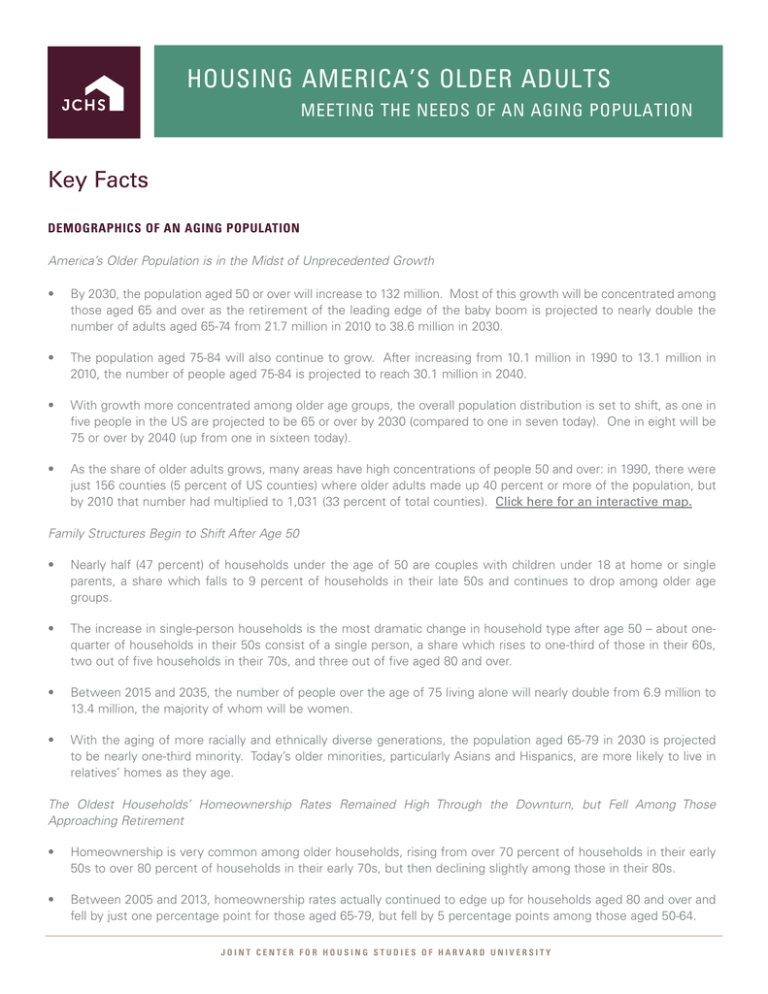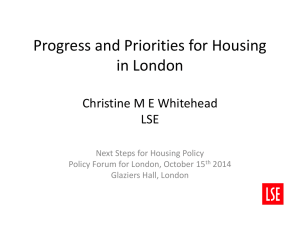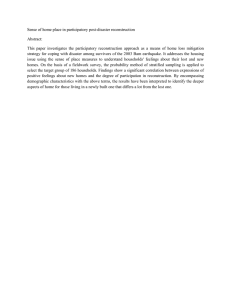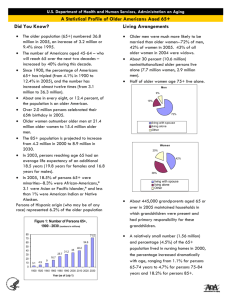HOUSING AMERICA’S OLDER ADULTS Key Facts
advertisement

HOUSING AMERICA’S OLDER ADULTS MEETING THE NEEDS OF AN AGING POPULATION Key Facts DEMOGRAPHICS OF AN AGING POPULATION America’s Older Population is in the Midst of Unprecedented Growth • By 2030, the population aged 50 or over will increase to 132 million. Most of this growth will be concentrated among those aged 65 and over as the retirement of the leading edge of the baby boom is projected to nearly double the number of adults aged 65-74 from 21.7 million in 2010 to 38.6 million in 2030. • The population aged 75-84 will also continue to grow. After increasing from 10.1 million in 1990 to 13.1 million in 2010, the number of people aged 75-84 is projected to reach 30.1 million in 2040. • With growth more concentrated among older age groups, the overall population distribution is set to shift, as one in five people in the US are projected to be 65 or over by 2030 (compared to one in seven today). One in eight will be 75 or over by 2040 (up from one in sixteen today). • As the share of older adults grows, many areas have high concentrations of people 50 and over: in 1990, there were just 156 counties (5 percent of US counties) where older adults made up 40 percent or more of the population, but by 2010 that number had multiplied to 1,031 (33 percent of total counties). Click here for an interactive map. Family Structures Begin to Shift After Age 50 • Nearly half (47 percent) of households under the age of 50 are couples with children under 18 at home or single parents, a share which falls to 9 percent of households in their late 50s and continues to drop among older age groups. • The increase in single-person households is the most dramatic change in household type after age 50 – about onequarter of households in their 50s consist of a single person, a share which rises to one-third of those in their 60s, two out of five households in their 70s, and three out of five aged 80 and over. • Between 2015 and 2035, the number of people over the age of 75 living alone will nearly double from 6.9 million to 13.4 million, the majority of whom will be women. • With the aging of more racially and ethnically diverse generations, the population aged 65-79 in 2030 is projected to be nearly one-third minority. Today’s older minorities, particularly Asians and Hispanics, are more likely to live in relatives’ homes as they age. The Oldest Households’ Homeownership Rates Remained High Through the Downturn, but Fell Among Those Approaching Retirement • Homeownership is very common among older households, rising from over 70 percent of households in their early 50s to over 80 percent of households in their early 70s, but then declining slightly among those in their 80s. • Between 2005 and 2013, homeownership rates actually continued to edge up for households aged 80 and over and fell by just one percentage point for those aged 65-79, but fell by 5 percentage points among those aged 50-64. Joint Center for Housing Studies of Harvard University H OUSING A M ERI C A ’ S O L DER ADU L TS — M EETING T H E NEEDS OF AN AGING P O P U L ATION • Contrary to the notion that older households move to different homes when they retire, the mobility rate continues to decline among those in their 60s and beyond, with a small uptick around age 85. In 2011, 60 percent of households aged 80 and older and 47 percent of those aged 65-79 had lived in the same residence for 20 or more years. • Older households who do move tend to stay within the same county or state, with family reasons most commonly drawing older households to move to another state. General Health is Improving Among Older Adults, but Challenges Still Arise with Age • The number of Medicare recipients reporting difficulty with activities of daily living declined by 22 percent between 1991 and 2009. Though health and quality of life are improving overall, 74 percent of Medicare beneficiaries living in their community reported two or more chronic health conditions such as diabetes, arthritis, Alzheimer’s, or heart disease. • About one in four older adults has a cognitive, hearing, mobility, or vision difficulty. By age 85, however, more than two in three adults face at least one of these difficulties. • Black and low-income older adults face higher rates of disability. About one-third (32 percent) of the black population aged 50 and over have at least one of six common difficulties (those associated with vision, cognition, self-care, hearing, independent living, and mobility), compared with about one-quarter of Hispanics, whites, Asians, and other minorities. Additionally, 45 percent of older adults with household income less than $15,000 have at least one difficulty, compared with 14 percent of older adults with household income of $75,000 and over. • With the prevalence of disability and chronic disease rising with age, 70 percent of people who reach age 65 will require long-term care in some form during their later years. HOUSING AND FINANCIAL SECURITY Despite Gains in Recent Decades, Income Challenges Remain Prevalent Among Oldest Households • Extended work lives have become more common among older households in recent decades, with nearly a third (31 percent) of households aged 65 to 69 continuing to work in 2013, up 9 percent from 1993. • Due to higher labor force participation rates, median household income of 65–69 year olds and 70-74 year olds are up 26 percent and 23 percent, respectively, over the past two decades. • Although income disparities by race/ethnicity, household type, and housing tenure are more apparent earlier in life, differences in income largely disappear as households reach their 80s, with median incomes for most of these groups below $30,000. • Assuming that the current income distribution of households aged 65 and over remains the same, 6.5 million households will have incomes under $15,000—a jump of 1.8 million, or 37 percent, in a single decade. • Growth in the number of older households with incomes between $15,000 and $29,999 would add another 2.9 million to the ranks of those with lower-incomes. A High Share of Older Households Face Housing Cost Burdens • In 2012, one-third of adults aged 50 and over—nearly 20 million households—were cost-burdened, meaning they paid over 30 percent of their income for housing. 2 • Joint Center for Housing Studies of Harvard University H OUSING A M ERI C A ’ S O L DER ADU L TS — M EETING T H E NEEDS OF AN AGING P O P U L ATION • Of the nearly 20 million older households paying excessive shares of their incomes for housing in 2012, nearly half (9.6 million) had severe housing cost burdens (paid more than 50 percent). • The average monthly housing costs of older adults owning their homes free and clear are less than a third of those with mortgages. As a result, owners still paying off mortgage debt are much more likely to be cost-burdened. • Housing cost burdens are most common among low-income older households, including three-quarters (77 percent) of those with annual incomes of less than $15,000 and more than half (54 percent) of those with incomes of $15,000– 29,999. • While less than a third (29 percent) of older white households were cost burdened in 2012, 39 percent of older Asian, 43 percent of older Hispanic, and 46 percent of older black households were cost burdened. Cost-Burdened Households Tend to Cut Back on Food and Health Care • Severely cost-burdened older households in the lowest expenditure quartile spend more than 40 percent less on food than households living in housing they can afford. Severely cost-burdened households aged 50–64 spend over 70 percent less on health care as well as on retirement savings compared to those living in housing they can afford. • Severely cost-burdened households aged 80 and over cut back most on health care, with outlays that are 59 percent lower per month than those of households living in affordable housing. Mortgage and Consumer Debt Burdens Continue to Rise for Older Adults • Seventy-three percent of homeowners aged 50–64 were still paying off mortgages in 2010, up 12 percentage points from 1992. • Accounting for inflation, non-housing debt among households aged 50–64 rose from about $8,700 in 1992 to $17,100 in 2010. There are Substantial Wealth Disparities Between Older Renters and Owners • The median net wealth of homeowners aged 50 and over in 2010 was 44 times that of renters in the same age group. • Excluding home equity, the median owner aged 50 and over still had $117,000 in other assets, in sharp contrast to only $6,100 in net wealth accumulated by the median renter in the same age group. • In 2010, 58 percent of homeowners 50 and over had retirement accounts, while only 26 percent of renters had any savings in this form. • Lower-income and minority owners aged 50 and over hold most of their wealth in home equity, with housing wealth accounting for more than three-quarters (75 percent) of total net wealth among older homeowners in the bottom income quartile and for nearly 60 percent among those in the lower-middle quartile. • Low-income owners aged 50 and over took an especially big hit during the housing crash, with the median net wealth of older owners in the lowest income quartile plunging 30 percent between 2007 and 2010, while the net wealth of the highest-income owners dipped just 1 percent. • Median households aged 50–64 are now financially worse off than their counterparts in 1992 - this age group lost nearly a third (32 percent) of their net wealth between 2007 and 2010. 3 • Joint Center for Housing Studies of Harvard University H OUSING A M ERI C A ’ S O L DER ADU L TS — M EETING T H E NEEDS OF AN AGING P O P U L ATION Rapid Growth in Low-Income Older Renters Will Put Pressure on Housing Assistance Programs • Of 3.9 million very low-income renter households aged 62 and over who were eligible for rental assistance in 2011, just 1.4 million (36 percent) were able to secure this aid. • More than half (58 percent) of very low-income households aged 62 and over without assistance in 2011 faced either excessive housing costs, lived in severely inadequate units, or both. • If the current income distribution holds, the ranks of older households eligible for rental assistance will increase by 1.3 million between 2011 and 2020 and another 1.3 million between 2020 and 2030. • Absent an increase in housing assistance efforts, by 2030 there will be 4 million very low-income renters left to to find affordable and adequate housing in the private market. • In 2013, 1.1 million renters aged 62 and over lived in either public housing or privately owned developments with unitbased assistance, while another 483,000 (30 percent) relied on housing choice vouchers. • Since 1987, low income housing tax credits have generated roughly 320,800 units for older renters, with 65 percent of those units newly constructed. • The Section 202 program, which has served as the primary means of expanding housing with supportive services for older adults, faces many pressures, with subsidy contracts on an estimated 41,900 units set to expire by 2024. ACCESSIBILITY NEEDS AND THE EXISTING STOCK The Majority of Older Adults Live in Single Family Homes • Most older adults own single-family homes, including over two-thirds of those aged 50-64, nearly three-quarters of those aged 65-79, and three-fifths of those aged 80 and over. • However, nearly 21 million older adults rent their home. • Less than two percent of adults aged 50-64 and 65-79 live in group quarters (nursing facilities, supervised care settings, etc.) but the share climbs to over 8 percent of adults aged 80 and over. Most Homes have Some Accessibility Features, but Demand Far Outstrips Supply • Single-floor living—with a bedroom and bathroom located on the same level—is the most common home feature that improves accessibility for those with mobile difficulties, available in 76 percent of US housing units. • Additionally, 44 percent of homes have easily reachable electrical switches and outlets, 42 percent have no-step entries, 8 percent have extra-wide hallways and doorways, and 8 percent have lever-style door and faucet handles. However, 43 percent of homes have none of these five features, or only one. • Accessibility features are more common in new homes, as units built since 2000 are five times more likely to have lever handles than those built before 1940, and more than twice as likely to have extra-wide doors and hallways and no-step entries. Nonetheless, just one in six homes built since 2000 has extra-wide doors and hallways, one in five has lever-style handles, and one in two has a no-step entry. • Though over one third of older renters live in attached single-family homes or smaller multifamily buildings of fewer 4 • Joint Center for Housing Studies of Harvard University H OUSING A M ERI C A ’ S O L DER ADU L TS — M EETING T H E NEEDS OF AN AGING P O P U L ATION than 10 units, these structures are least likely to have multiple accessibility features. • Fewer than half of all older households headed by someone with serious difficulty walking or climbing stairs live in a home with a no-step entry. • Though older adults are more likely than younger adults to live in homes with at least one accessibility feature, the gap between the need for accessible units and the likelihood of living in such a home increases as people age – adults aged 80 and over are nearly twice as likely to have a disability (61 percent) as to live in a home with three or more accessibility features (31 percent). Older Households May Move or Renovate to Improve Home Accessibility • Though moving becomes less frequent with age, older households that do move are more likely to choose homes with universal design features – about one quarter of movers in their 50s and 60s, more than one third in their 70s, and more than one third in their 80s move to homes with three or more accessibility features. • More than 90 percent of households in their 80s that move relocate to homes with single-floor living, while 63 percent move to homes with no-step entries and 35 percent move to homes extra-wide doors and hallways. • While some accessibility improvements to support aging in place can be made relatively easily, others can be complex and costly – installing grab bars and grips in bathrooms, handrails on both sides of a stairway, and lever-style handles on doors and faucets can cost under $1,000, while widening one doorway can cost $800-1,200, installing a wheelchair ramp can cost $1,600-3,200, and installing a stair lift can cost $3,000-12,000. • 5.5 million older households include someone with mobility difficulty but live in homes without no-step entryways; installing ramps in all of these homes at an average cost of $2,400 each would cost $13.2 billion, representing both the outsized extent of need for accessible homes and the opportunities for the remodeling industry in addressing these needs. Though Accessibility Features are More Common in HUD-Assisted Rental Units, Supply Remains Short • Rental units subsidized by the U.S. Department of Housing and Urban Development (HUD) are more likely to have accessibility features, as 48 percent include a no-step entry compared with 37 percent of unassisted low-cost units, 12 percent have extra-wide doors and hallways (vs. 6 percent), and 10 percent have lever-style door handles (vs. 5 percent). • Still, just over one-quarter of assisted rental units have three or more accessibility features. • Very few private units exist that are both affordable and accessible – only 551,000 unassisted units rent for $400 per month or less and have at least three accessibility features. Innovative Policies are Emerging to Support Home Accessibility • First advocated in the late 1980s by the nonprofit Concrete Change, visitability standards that help ensure home accessibility for both residents and their guests have been adopted by various states and municipalities, leading to the construction of homes with no-step entries, main-floor accessible bathrooms, wide interior doors and hallways, reachable electrical outlets and switches, and reinforced walls for later installation of grab bars. • State and local tax credits for installation of accessibility features defray the costs of new construction and home remodeling in some areas including Georgia, Ohio, Virginia, and Pennsylvania. 5 • Joint Center for Housing Studies of Harvard University H OUSING A M ERI C A ’ S O L DER ADU L TS — M EETING T H E NEEDS OF AN AGING P O P U L ATION SOCIAL CONNECTION AND COMMUNITY SUPPORT The Older Population is Growing Rapidly Across the U.S. and Within Specific Communities • Nearly half of households aged 50 and over live in the suburbs and exurbs of metropolitan areas. The remaining half are evenly divided between core cities and rural communities. • Age-restricted communities provided housing for about 2.2 million households headed by someone aged 55 and over in 2001 and about 3.0 million in 2011. Residents are evenly split between renters (1.6 million) and owner-occupants (1.4 million). The Car-Centric Nature of the U.S. Can Make it Difficult for Those Unable to Drive • Even though most older adults drive, 61 percent limited their driving to certain hours of the day, and around 21 percent stated that they frequently or occasionally miss out on activities they like to do because of driving limitations. • About 24 percent of households aged 80 and over in 2009 were carless, compared with just 9 percent of households aged 65–79. • About 52 percent of older adult households report having transportation services in their area, but in a survey, the vast majority with transit nearby had not used the service in the previous two months. The Availability of Services to Support Aging in Community is Critical • 1 million adults visit one of the approximately 11,400 senior centers in the United States every day to take advantage of health and wellness programs, recreational opportunities, counseling on public benefits, or referrals to other service providers. • Funding from the Older Americans Act reaches about 11 million older adults, including 3 million who regularly receive services such as in-home care, adult day care, meals, transportation, and support for family care providers. LINKING HOUSING AND LONG- TERM SUPPORTS AND SERVICES Many Older Adults with Disabilities Live in the Community • Despite the growth of the older population in recent years, the number of adults living in group quarters has actually shrunk, with the share of the 65-and-over population in nursing facilities falling by 20 percent between 2000 and 2010. • More than 90 percent of individuals aged 65 and over who have disabilities live in private homes. • While most adults aged 65 and over with disabilities who reside in a private home live with a spouse, partner, or other family member, the share of this group living alone increases with age, rising from 22 percent of those aged 50–64 to more than a third (35 percent) of those aged 80 and over. However, Institutional Care Continues to Play Critical Role in Addressing Long-term Care Needs of Older Adults • In 2013, home health agencies served approximately 4.7 million of the 8.4 million recipients of long-term services and supports. • 1.4 million people (not necessarily all over the age of 50) were residents of nursing homes at any given time in 2012; these institutions serve more than 3 million people annually. 6 • Joint Center for Housing Studies of Harvard University H OUSING A M ERI C A ’ S O L DER ADU L TS — M EETING T H E NEEDS OF AN AGING P O P U L ATION • The number of people receiving long-term care (in the home, as well as in nursing, assisted living, and similar facilities) will increase from 15 million in 2000 to 27 million in 2050. • Older adults in need of long-term care are a particularly vulnerable group; in a 2000 survey of nursing home residents, 44 percent of respondents cited incidents of abuse. Paying for Long-Term Care Can be Difficult for Older Households • In-home care costs for older households can be substantial—the median monthly cost for 30 hours of weekly service is $2,500–$2,600. • The typical homeowner age 65 and over has enough wealth to cover the costs of in-home assistance for nearly nine years or assisted living for 6 and half years. The typical renter, however, can only afford two months of these supports. • Long-term care policies are expensive and the premiums are beyond the reach of many older adults; in 2010, policyholders aged 65–69 paid, on average, $2,781 annually for long-term care insurance and those aged 75 and over paid $4,123. • Despite its high costs, private insurance benefits subsidize only 60–75 percent of long-term care costs. • Medicaid plays a critical role in financing the long-term care needs of low-income households in institutional settings, including two-thirds of nursing home residents aged 65 and over. • In 2009, Medicaid-funded home- and community-based services (HCBS) waiver programs, which cover long-term care in the home, paid for modifications to the homes of 36,400 recipients, with expenditures totaling $106 million. • Two out of three older adults with disabilities who receive long-term care services at home get their care exclusively from family members—primarily wives and adult daughters. • 16 percent of the youngest baby boomers, aged 50–59, do not have children who might take care for them in older age. • Due in part to demographic shifts, AARP estimates that the ratio of potential family caregivers to those over 80 will fall from 7-to-1 today to 4-to-1 by 2030, and to less than 3-to-1 by 2050. SPONSORS Principal funding for this report was provided by a grant from the AARP Foundation with support from The Hartford. Additional support provided by the Policy Advisory Board of the Joint Center for Housing Studies. FOR MORE INFORMATION, COntact Kerry Donahue, (617) 495-7640, kerry_donahue@harvard.edu Hillary John, (202) 434-2560, hjohn@aarp.org 7 • Joint Center for Housing Studies of Harvard University





